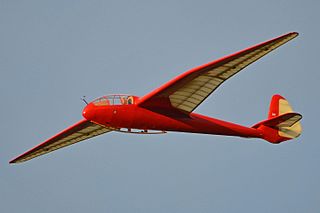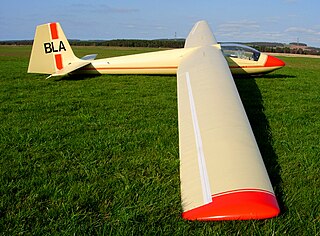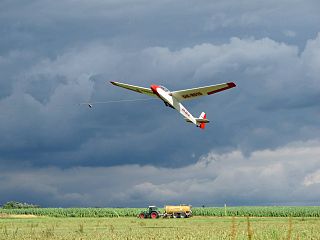
The Scheibe Spatz is a German glider with a mixed metal and wood construction that was built in 1952 until 1962. Later versions were known as the L-Spatz, the letter L standing for Leistung, which is German for "performance".
The PIK-3 was a sailplane produced in Finland in the 1950s and 60s. It was designed to be a cheap and easy-to-build aircraft to equip the country's gliding clubs as their standard single-seat machine. It was a conventional design for its day, with a high wing and conventional empennage. Construction was of wood throughout, skinned in plywood.

The SZD-22 Mucha Standard was a single-seat aerobatic glider designed and built in Poland from 1957.
The Slingsby T.25 Gull 4 is a British glider designed and built by Slingsby that first flew in 1947.

The Eon Olympia was a glider produced from 1947 by Elliotts of Newbury.

The Scheibe Bergfalke is a German glider designed by Egon Scheibe as a post-World War II development of the Akaflieg München Mü13 produced before and during the war.

The Slingsby Type 45 Swallow was designed as a club sailplane of reasonable performance and price. One of the most successful of Slingsby's gliders in sales terms, over 100 had been built when production was ended by a 1968 factory fire.

The Slingsby T.13 Petrel was a British single-seat competition glider built by Slingsby Sailplanes just before World War II.

The Slingsby T.50 Skylark 4 was a British single seat competition glider built by Slingsby Sailplanes in the early 1960s. It sold in numbers and had success at national, though not world level competition.

The Schleicher Ka-4 Rhönlerche II, sometimes called the KA-4 or even K 4, is a West German high-wing, strut-braced, two-seat glider that was designed by Rudolf Kaiser and produced by Alexander Schleicher GmbH & Co.

The Schleicher K7 Rhönadler is a West German high-wing, two-seat, glider that was designed by Rudolf Kaiser and produced by Alexander Schleicher GmbH & Co.

The Cijan-Obad Orao is a competition single seat sailplane designed in Yugoslavia just after World War II, one of the most advanced of its type at the time. It flew in three World Gliding Championships, having greatest success at its first in 1950 when it reached third place.

The Wassmer WA 20 Javelot and its very similar successors the WA 21 Javelot II and WA 22 Super Javelot are single seat gliders built in France in the 1950s and 1960s. Well over a hundred were sold as club aircraft and over fifty remain on the French civil register in 2010.
The Horikawa H-23B-2 is a two-seat training glider designed and built in Japan in the 1950s. It was produced in small numbers.
The Kometa-Standard was a Standard Class glider, designed and built in Bulgaria in the early 1960s. Thirty were flown by local gliding clubs.
The UTG-1 Loudon was an intermediate glider designed and built at the University of Toronto in Canada during the late 1940s.
The IS-2 was an intermediate training glider designed by Iosif Şilimon and built in Romania in the 1950s at the URMV-3 factory at Brașov.
The IS-4 was a high performance glider designed by Iosif Şilimon and built in Romania in the late 1950s at the URMV-3 factory at Braşov.

The Scheibe Specht is a tandem seat training glider produced in Germany in the early 1950s. More than fifty were built.

The Schleicher Ka-2 Rhönschwalbe is a tandem two-seat training glider designed and built in Germany, in 1952.














